| Basic Specifications | |
|---|---|
| Full model name: | Sony Alpha NEX-6 |
| Resolution: | 16.10 Megapixels |
| Sensor size: | APS-C (23.5mm x 15.6mm) |
| Kit Lens: |
3.13x zoom
16-50mm (24-75mm eq.) |
| Viewfinder: | EVF / LCD |
| Native ISO: | 100 - 25,600 |
| Extended ISO: | 100 - 25,600 |
| Shutter: | 1/4000 - 30 sec |
| Max Aperture: | 3.5 (kit lens) |
| Dimensions: |
4.7 x 2.6 x 1.7 in. (120 x 67 x 43 mm) |
| Weight: |
16.5 oz
(469 g)
includes batteries, kit lens |
| Availability: | 11/2012 |
| Manufacturer: | Sony |
| Full specs: | Sony NEX-6 specifications |
NEX-6 Summary
Squeezing into Sony's compact system camera lineup between the acclaimed NEX-7 and the NEX-5R, the NEX-6 stands on its own as a high-performing hybrid -- marrying exceptional speed and image quality with more consumer-friendly features and controls. While it gets a bump down in resolution compared to the NEX-7, the 16.1-megapixel APS-C sensor still delivers photos with sharp detail and good color, contrast and exposure. And though the NEX-6's "Fast Hybrid AF" system lags somewhat behind higher-end DSLRs, it's nonetheless pretty fast and decisive, especially on stationary and normal moving (not sports) subjects. Lightweight and compact, sharp and fast, advanced and easy-to-use: What more could you want from a camera at such an affordable price?
ProsVery good image quality; More consumer-friendly control setup than NEX-7 but more advanced (actual Mode dial) than step-down models; OLED EVF and 3-inch tilting LCD monitor provide viewfinder flexibility; Fast and decisive AF on stationary subjects, and good continuous AF on normal moving subjects; Full HD 1080p video recording at up to 60p.
ConsHybrid AF system speed and accuracy still lags somewhat behind higher-end DSLRs; Wi-Fi features still rudimentary (join the club); LCD is not a touchscreen; User interface foibles.
Price and availabilityThe Sony NEX-6 began shipping in the U.S. market in November 2012, priced at US$850 body only and US$1,000 with the 16-50mm kit lens.
Imaging Resource rating5.0 out of 5.0
-
EXMOR + BIONZ
Capture images of unsurpassed splendor
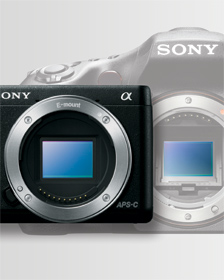
Sony’s 16.1 megapixel* Exmor® APS HD CMOS sensor—the same size as found in larger DSLRs—works with BIONZ® image processing to deliver images of astounding beauty. Brilliant lifelike colors, superb details and smooth tonal gradations are all hallmarks of this renowned duo. Whether viewing on a wide-screen TV or making oversized prints, the high-resolution, low-noise images reveal every subtle nuance of a scene, be it a majestic landscape or slice of dynamic city life. In addition, the high resolution offers more freedom when cropping photos without sacrificing image quality
This content provided and sponsored by Sony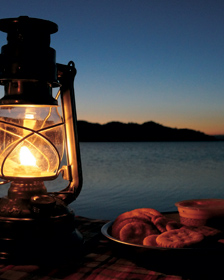
Preserving the natural beauty of delicately lit low-light scenes Never worry about ruining the lovely atmosphere of a warmly lit interior or sparkling night scene. The ultra-high ISO of 25,600 lets you shoot without flash for images that faithfully convey the ambiance of the setting, while NEX-6’s noise reduction technology markedly reduces noise that occurs when shooting at high ISO sensitivity. You’ll also appreciate the freedom high ISO sensitivity provides, allowing you to shoot at fast shutter speeds to eliminate the need for a tripod or to capture fast-moving action.
This content provided and sponsored by Sony -
Fast Hybrid AF
New autofocus system for DSLR-like response
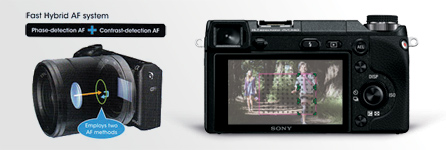
The NEX-6 is as fast as the world you're trying to capture. Sony's advanced Fast Hybrid AF* combines two technologies for outstanding performance: Phase detection autofocus for quick response that is ideal when tracking fast-moving subjects and contrast-detection autofocus for added precision. It's a perfect match that delivers fast, precise, focusing anywhere and everywhere.
Four focus modes cover any scene or subject, matching the focus mode to the subject assures super-sharp results. Choose from Single-shot AF for static subjects, Continuous AF for moving subjects and Manual Focus or Direct Manual Focus (DMF) for close-ups.
This content provided and sponsored by Sony -
High-Speed
Continuous ShootingFocus and shoot at the speed of life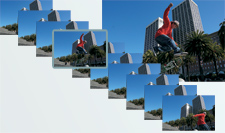
Rely on NEX-6 to flawlessly capture any fast-breaking action. Speed Priority Continuous mode is capable of up to a blazing 10 fps while maintaining focus on the subject thanks to Fast Hybrid AF, producing exciting action sequences with each frame perfectly focused.
This content provided and sponsored by Sony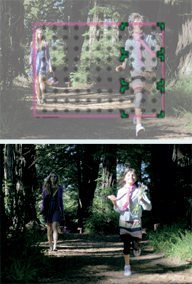

Automatically maintain focus on moving subjects with Object Tracking. Just select the subject and the camera locks on, keeping it sharply focused as it moves—a great help when shooting action scenes.
This content provided and sponsored by Sony -
Full HD Movies
Full HD movies

Record beautiful movies thanks to the Exmor® APS HD CMOS sensor and fast readout. NEX-6 supports a variety of movie formats, including AVCHD™ Ver. 2.0 at 60p(!) and 60i as well as 24p*. Shoot carefree in fully automatic mode or use P/A/S/M modes when you want maximum control over the look of the movie, the choice is yours. In addition, a wide variety of optional A-mount lenses are available to offer aspiring moviemakers all the tools they need to produce stunning cinema.**
*1080 60i devices
This content provided and sponsored by Sony
** Attaching Sony A-mount lens requires LA-EA1 or LA-EA2 adapter (both sold separately). Autofocus available with SSM and SAM series lenses. -
XGA OLED
Tru-finderBuilt-in, ultra high-resolution electronic viewfinder
Experience for yourself the brightness and clarity that define XGA OLED Tru- Finder™. Boasting 2,359K-dot resolution and outstanding contrast, this superb viewfinder reveals every subtle nuance of a scene with remarkable accuracy, including defocussing effects, so what you see is literally what you get. Fast OLED response virtually eliminates motion blur and residual images when tracking moving subjects or viewing recorded movies. In addition, a digital level gauge displays camera roll (left/right tilt) and pitch (front/back tilt).
This content provided and sponsored by Sony -
Tiltable LCD Screen
Tiltable LCD screen for the greatest of viewing ease
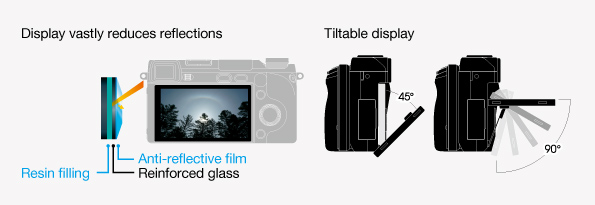
Enjoy the clarity of the 3.0" (7.5 cm) 921K-dot LCD screen. The resin-filled design vastly reduces internal reflections for easy viewing, delivering rich blacks, brilliant colors and a realism that is nothing short of amazing, all beautifully displayed in any lighting situation. For expanded viewing convenience, the display tilts approx. 90° up and 45° down.
This content provided and sponsored by Sony -
Built-In WiFi
Wi-Fi connectivity with mobile devices and more

Forget the cable -- Never again be stuck with your photos on your camera instead of where you want them. Built-in Wi-Fi lets you view photos on just about any wireless-compatible device. For smartphones and tablet PCs, simply install PlayMemories Mobile™* -- a free mobile app -- and transfer photos directly from the camera. You can also connect wirelessly to compatible wide-screen TVs to view photos, using the camera as a remote control. And when it’s time to download photos and movies to a PC on which PlayMemories Home™* is installed, do it wirelessly without bothering with cables.
*Requires an active 802.11 Wi-Fi network (802.11n recommended) or PlayMemories Mobile™ app installed on compatible AndroidTM or iOS device.
This content provided and sponsored by Sony -
Unique Features
Unique features
Auto Portrait Framing
Give portraits a professional look. NEX-6 automatically crops images while you shoot for the most pleasing look. It also saves the original so you can decide which is best.Smile Shutter™/ Face Detection
Capture people when they are at their most charming. The camera waits until faces are smiling then automatically takes the shot. Smile detection is adjustable in three levels.Superior Auto
This convenient mode offers the ultimate in shooting freedom. The camera reads the scene then automatically adjusts settings for superb, hassle-free photos and movies.Sweep Panorama™ Mode
This content provided and sponsored by Sony
Majestic landscapes and cityscapes can now be captured with ease. Just sweep the camera in an arc while shooting and the camera automatically creates a stunning panorama. -
Ingenious Apps
Ingenious apps

Vastly expand artistic possibilities with six new Picture Effect modes: Partial Color+ (now with the ability to highlight two colors and their similar hues), Watercolor, Illustration, Soft High-Key+, Miniature+ and Toy Camera+.
This content provided and sponsored by Sony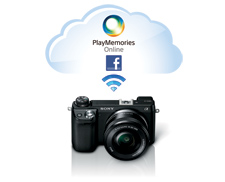
Upload photos via Wi-Fi directly from NEX-6 to networking services like PlayMemories OnlineTM and Facebook®, with more services available in the future.
This content provided and sponsored by Sony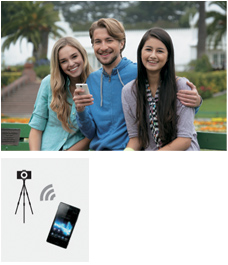
Check framing and adjust exposure then release the shutter using your smartphone. This is ideal for group shots or when shooting with a tripod. After the shot, photos will be automatically sent to your smartphone.
This content provided and sponsored by Sony
Sony NEX-6 Review
Overview by Shawn Barnett and Mike Tomkins
Posted 09/12/2012
Field Test by Eamon Hickey
Posted 04/18/2013
This is the Sony we've been waiting for. Not just the camera, but the company. They are back in fighting form, and what's more they seem to be having fun. Sony wasn't sure the NEX-7 would be quite the smash hit it clearly was, even at its higher price point, but that smash hit told them there was a market for a small mirrorless camera with an electronic viewfinder and an extra dial for a slightly lower price point. Hence we have the Sony NEX-6: a camera that's about the size of an NEX-7 complete with pop-up flash and electronic viewfinder, but with a simplified interface and a 16.1-megapixel sensor instead of 24.3. It also has a real Mode dial, dog-gone it, and that's a welcome change.
Between the NEX-6 and the NEX-5R, Sony has developed two cameras that hit us just about right. Stick a hot shoe on the NEX-5R and we're happy; barring that, we're drawn to the NEX-6 with its physical Mode dial. We might even use the electronic viewfinder.
What's new. Of course, there's a whole lot more to the Sony NEX-6 than those few elements. First, Sony's added its "Fast Hybrid AF" system, which combines contrast detection with 99-point phase-detection autofocus. It's reassuring to see that 11 x 9 array of autofocus points on the screen (both EVF and LCD, of course). Next, it can shoot 10 frames per second at full 16-megapixel resolution while track-focusing, keeping moving subjects in focus. The NEX-6 also records Full HD movies at 60p -- no small feat -- and it has Sony's new Multi Interface Shoe, which not only supports standard flashes, it integrates 21 additional pins for adding accessories to the camera. Finally, Sony integrated a Wi-Fi radio for easy transfer of images either directly to social media or to tablets and cell phones for editing and uploading from there.
And because it's a Sony, it has a huge selection of extra features that users have come to expect. Things like Sweep Panorama, Auto Portrait Framing (a crazy idea that actually seems to work), Auto HDR, and Focus Peaking function, just to name a few.
Initial pricing was set at US$850 body-only, and US$1,000 with the new 16-50mm Power Zoom lens, which started to ship in November 2012.
Build and design walkthrough. Physically, the NEX-6 reminds us a lot of the NEX-7. It's almost exactly the same size, measuring 4.7 x 2.6 x 1.7 inches (120 x 67 x 43mm) and weighing 12.7 ounces (359g) with battery and card (without lens). It weighs 16.5 ounces (469g) ready to shoot with the 16-50mm kit lens.
With a more workman-like appearance, the Sony NEX-6 has less glitz and more down-home practicality than the NEX-7. It isn't homely, but it's not headed out for dinner and dancing in the city. Sony softened the corners and spatter-painted the surfaces. All the major features are right where you'd expect them, though: the infrared remote port on the grip, a good feel to the grip, an AF-assist lamp, lens release button where it should be, left and right microphone holes flanking the lens, and that relatively large APS-C sensor.
Multi Interface Shoe. Not only does the NEX-6's hot shoe now accept standard flash units, it has an additional connector tucked under the front of the shoe, for communicating with intelligent accessories.
From the top. Sony's new 16-50mm Power Zoom lens lets the NEX-6 fit more comfortably into jacket pockets and bags, and is a welcome addition to the line. The overall profile of the NEX-6 is a little thicker behind the lens mount. Whereas the NEX-7 used Minolta's old proprietary hot shoe, Sony's new Multi Interface Shoe appears on the NEX-6, making it compatible with upcoming intelligent accessories as well as standard non-dedicated strobes. The EVF's rubber eyecup is also noticeably larger on the Sony NEX-6, and it's softer so it'll do less damage to glasses. Right of the hot shoe is the pop-up flash, which springs up quickly, hanging over the Sony logo. Sony seems to have settled on putting the Power switch around the shutter button on its latest NEX cameras, and the Function button is also becoming standard. Finally, the Mode dial features PASM, fast access to Scene modes and Sweep Panorama, as well as the two Intelligent auto modes. It's stacked above the Control dial which we appreciate so much (it really does make us happy, because cameras like the NEX-5 and NEX-3 relied too much on soft controls to make important changes).
Sony's wholesale switch to the use of D-rings for camera straps is unfortunate thanks to their tendency to rattle in video recordings, but someone apparently decided it was necessary. We should also note that we found the gap between the lens and grip a little tight.
On the back. Function over form rings true again when looking at the back. Comparing this to the NEX-7 is like being introduced to the high-school jock's bookish little brother: the family resemblance is there, but the emphasis on appearance is different. Handsome as we find the NEX-7, we're happy with bookish if it gets us the photos we want in a practical way. The diopter correction dial is a little harder to activate thanks to the large rubber eyecup, but it's possible. The pop-up flash button is mechanical, not electronic, which we prefer in a camera like this. The Playback button does not power-up the camera, which makes sense considering the type of power switch employed. The AEL button is not switchable as it is on the NEX-7, but that's easy to live with; we're just happy it's there, and it is programmable. The standard soft buttons flank the top and bottom right corners of the LCD, their purpose changing with the mode or menu. Some, no doubt, are disappointed that the LCD is not a touchscreen, but we didn't miss it while shooting. It would have been very useful for entering text via the virtual keyboard, though.
Three of the four buttons integrated into the Control wheel bring up smart, fast adjustment menus on the right side of the screen, while the DISP button cycles through the various display options.
Battery and storage. The NEX-6 is powered by a 7.2-volt InfoLITHIUM rechargeable battery (part number NP-FW50) which is CIPA-rated to take 360 still images on a single charge while using the LCD screen. That's pretty good for a CSC, but battery life drops to 270 shots when using the EVF. The battery is charged in-camera via the USB port, and an AC adapter and USB cable are included in the product bundle, however a dedicated battery charger is not.
The NEX-6 accommodates several types of recordable media, including Memory Stick PRO Duo, Memory Stick PRO-HG Duo and SD/SDHC/SDXC memory cards, and is UHS-I compliant. The camera captures images in JPEG (Standard, Fine), 12-bit RAW and RAW+JPEG file formats.
Connectivity. In addition to built-in Wi-Fi and the Multi Interface Hot Shoe, connectivity options include USB 2.0 High-Speed for data transfer (and charging), and a high-definition Type-C Mini HDMI video output with CEC support. Like other recent Sonys, there is no provision for standard-definition composite video output. The Sony NEX-6 also has an infrared receiver in the grip for use with the optional RMT-DSLR1 or RMT-DSLR2 wireless remotes.
Overall impressions. All in all, the Sony NEX-6 strikes us as a just-right answer to the enthusiast's need for a more affordable mirrorless camera. It boasts improved continuous autofocus that can track a subject while firing off 10 frames per second, an electronic viewfinder, an articulating LCD screen, more physical control dials than anything but the NEX-7 -- less complexity than the NEX-7 -- and has a high-quality 16.1-megapixel APS-C sensor that does well in low light. We also appreciate the USB charging function, making it easier to charge while on the road, and you can always purchase a dedicated battery charger if you need one. Built-in Wi-Fi adds even more value to the NEX-6, allowing easy uploads direct to social media and transfers to tablets and phones. And adding the 16-50mm retractable Power Zoom lens makes the Sony NEX-6 smaller and easier to bring along as well as easier to afford.
Sony NEX-6 Field Test
By Eamon Hickey
I might be the perfect target customer for the Sony NEX-6. I've shot with advanced and professional SLR cameras (film and digital) for 20 years, but I'm ready -- more than ready -- to lighten my camera load. I put the NEX-6 through its paces over several shooting days in New York City, hoping it might be my holy grail: a serious photographer's camera in a very compact package.
Size and feel. As we already noted, the Sony NEX-6 is quite compact, and the new retractable SEL16-50mm f/3.5-5.6 OSS lens, which was included with my test unit, definitely helps keep weight and size in check. I could just slip the camera/lens combination into a large-ish coat pocket, allowing it to qualify (barely) as compact in my book. On three different days I spent 3 to 4 hours traipsing all over Manhattan with it and barely noticed its weight or bulk -- exactly what I was hoping for.
Happily, I also noticed right away how easy the camera is to hold securely, thanks to its prominent grip and tacky surface texture. I often like to walk with my camera dangling in my right hand, as opposed to hanging from a shoulder strap, and the Sony NEX-6 is among the best cameras I've ever tried for carrying this way.
Focus and overall speed. As much as I love the new compact system cameras, I've never met one that could focus well on anything capable of propelling itself, and kludgy manual focus systems are the lamentable rule with these cameras. One big promise of the Sony NEX-6 is that it might change that.
So the first thing I did with the NEX-6 was to head to the ice skating rink at Bryant Park to test out the camera's new hybrid contrast/phase detection autofocus (AF), which is designed specifically to do a better job on moving subjects. On this visit and a later one, I used the Sony NEX-6 to shoot fast and medium speed skaters coming directly at me using continuous AF in both regular continuous drive mode (about 2-3 frames per second) and in speed priority drive mode (about 7-10 frames per second, depending on whether I was shooting in the raw or jpeg file format).
I'm happy to report that the Sony NEX-6 is not at all hopeless in this scenario. I got several sequences of four to eight consecutive shots with many shots in good focus, even when using frame rates up to about 8 frames per second.
Now for the caveats: For moving subjects, the Sony NEX-6 AF system still lags behind the performance of higher-end DSLR cameras from Canon and Nikon that I've used, and it's a far, far cry from those companies' pro DSLR models. Nobody is getting a staff job at Sports Illustrated with the NEX-6. For one thing, initial focus acquisition is noticeably slower than that of a good DSLR; very quick, swing-to-the-action shots are iffy at best. Equally important, my hit rate was decent but not excellent -- only about 50% of my skating test shots were sharp (though I should caution that this was by no means a complete test).
| | unadjusted JPEG | |
I should also add that I was shooting in bright sunlight, and the 16-50mm kit lens can't really stress test the AF system because it has deep enough depth-of-field, even when wide open, to hide some focusing errors. Shooting a basketball game in a dark gym with a 300mm f/2.8 lens would probably yield a much different, much blurrier story.
With those qualifications noted, I'd rate the ability of the Sony NEX-6's continuous AF as reasonably competent. More to the point, it's easily good enough for my style of shooting. As it does almost like clockwork, New York's endless variety of life manifested itself at the ice rink on my second visit, in the form of a white-haired gentleman skating in his business suit, and the NEX-6 had no trouble nailing a number of sharp pictures of him gliding swiftly through his lunch break. Capturing moving people moving about normally -- rather than pro athletes zooming down the court or field or ski slope -- is the kind of shot I need decent AF for, and the NEX-6 did the job.
On the other hand, the first thing I like to do on any camera that I'm using is to separate AF activation from the shutter release button. This is one of the great unsung camera features -- it simultaneously gives you most of the advantages of both auto and manual focus -- and the Sony NEX-6 doesn't have it. Not sure I could live without that.
On still subjects, I found the Sony NEX-6's AF to be both quick and decisive. After my second visit to the Bryant Park rink, I walked three blocks to Grand Central Station where I spotted a young soldier standing with a duffel bag and reading a map, clearly on his first visit to New York. These are the kinds of shots I'm by far the most interested in getting these days, and they require a fast and sure camera. The NEX-6 quickly acquired focus on the soldier in the very dim light, letting me stop, shoot and move on in the space of about a second or two. I made many similar street-style shots in low light, and the camera's AF system worked well nearly every time.
| | unadjusted JPEG | | | unadjusted JPEG | |
I also liked the camera's focus peaking feature, which shows you the in-focus area with a bright glimmery highlighting (you can choose from several different colors for this highlight). It worked well for me, and I'm delighted to see Sony investing R&D effort on the ancient and seemingly unsexy art of manual focusing. I wish, however, that I could toggle directly, with one button push, between auto and manual focus; it's a two-step process on the NEX-6 no matter how you set it up.
It was clear from my first few shots with the Sony NEX-6 at Bryant Park that, in addition to autofocus, the rest of the camera's overall performance is pleasingly fast. Buttons responded quickly, shutter delay was minimal, images wrote speedily to the storage card and could be played back in just a second or two. In short, on that day and later days shooting with the camera, I never had to wait for it. That's a big deal to me when I'm wandering around looking to capture fleeting moments in the life of the city.
EVF/LCD. I loved the superb versatility provided by the two high-quality viewing options on the Sony NEX-6. It's hard to overstate the benefits here.
For the skating shots, I used the eye-level XGA Tru-Finder OLED electronic viewfinder (EVF), much like I would have with a traditional DSLR. At about 2,359,000 dots, it's sharp and responsive, and I had no trouble seeing the image even when shooting bright daylight scenes. No EVF that I've used can show the nuances of light, shadow, and color that you can see through a good optical viewfinder, but I don't expect that (yet). For composing shots, I had no trouble with the EVF in the NEX-6.
| | unadjusted JPEG | |
For most of my walk-around people and street shooting with the camera, I used the rear, tiltable LCD display for composing my pictures. As I moved through the crowds on Fifth Avenue, it was easy to make what we used to call Hail Mary shots, holding the camera high above my head and framing with the LCD tilted down.
For most other street shots -- the travelers in Grand Central Station, subway passengers, coffee house patrons -- I used the NEX-6 more or less at waist level, composing with the LCD tilted up. In my experience, people feel a lot less threatened when you shoot this way, compared to holding the camera to your eye. I've never been punched in the nose while street shooting, and I'd love to keep it that way. Like the EVF, the LCD is sharp and responsive, and I had no trouble viewing it in bright daylight.
Controls. Overall, I was fairly happy with the enthusiast-oriented control interface of the Sony NEX-6 as I shot with it, but I have some quibbles. I feel like Sony climbed three-quarters of the way to the top of the mountain, then just stopped.
With two control wheels -- one for aperture and one for shutter speed -- and a constant, real-time exposure readout in the form of a live histogram, the NEX-6 let me quickly control the exposure basics in manual or automatic exposure modes. The ISO setting is also accessed with a dedicated button, and I could change it quickly as I moved from subway station to street to Starbucks to sunlight to shade.
So far, so good, but then Sony blew it, in my not so humble opinion. You can't directly access exposure compensation when in automatic exposure mode. You have to click a button and enter a different control mode, and when you do, the live histogram disappears, so you can't see what your adjustments are doing to the exposure as you make them. (The histogram reappears when you go back to shooting mode.) This system is just bafflingly dumb. If they let you assign exposure compensation to the rear control dial (which is just sitting there, forlornly, with no purpose in automatic exposure mode) and kept the histogram active, Sony would in one fell swoop double the usability of the NEX-6's exposure system. I lamented this every step I took with the NEX-6.
Also baffling to me was that I could not save custom sets of camera settings, which would have allowed me to have, for example, a high ISO setup for shooting in the subway and a daylight setup for shooting above ground -- and then switch between them quickly as I walked down the stairs into a train station. I honestly didn't believe any serious camera made these days could lack this feature.
The way I shoot, I use other camera functions much less often, and I think Sony struck generally a good balance between direct button access and menu diving. The company touts the Quick-Navi interface on the NEX-6 -- basically a display of functions on the LCD, enabling two-button access to all of them -- but I found no real advantage to it over the camera's other pathways for accessing the same features.
Lens. For my style of shooting, especially in and around New York, the 16-50mm focal length of Sony's new E-mount kit lens (24-75mm in 35mm equivalent terms) was perfect. The unusually wide lower end of that range let me capture buildings and public spaces in the close quarters of this crowded city, and the rest of the range was ideal for shooting people on the streets and in cafes and restaurants.
As I walked and shot, I did struggle a bit with both the power zoom and the fly-by-wire manual zoom functions on the SEL 16-50mm, sometimes finding it difficult to precisely control the focal length. I also briefly stumbled a few times when I switched to manual focus and forgot that the ring would no longer zoom the lens. But these were minor issues, and I'd almost certainly learn to avoid them with more time shooting the camera.
Wi-Fi and special features. I downloaded and installed two of Sony's PlayMemories apps for the NEX-6: Smart Remote Control (which works with PlayMemories Mobile running on a smartphone or tablet) and Direct Upload. We're definitely in the frightening land of Very Early Stage Technology here. The instructions and dialogs for creating Wi-Fi connections are barely intelligible, like throwbacks to the entertainingly cryptic Japanese instruction manuals of the 1960s. And the apps are, at this point, fairly rudimentary, with very limited features and capabilities. Still, if you can decipher them, they work, and later versions will undoubtedly offer more and better features.
| The Sony NEX-6 produces beautiful panoramic images almost effortlessly. |
| | unadjusted JPEG | |
Of the Sony NEX-6's many special features, I was most interested in the Sweep Panorama and Handheld Twilight modes. When using Sweep Panorama, the camera guided me through a sequence of handheld shots and then automatically stitched them together. The result was a pretty amazingly sharp and artifact-free panorama.
I tested Handheld Twilight mode one evening in my neighborhood, capturing evocative shots of the streetlights and restaurants of Second Avenue. This feature, too, works almost magically, producing colorful, sharp handheld images of night scenes -- a great boon for a guy like me, who wants to leave his tripod in the closet where it belongs.
Movies. I also shot some video test clips with the Sony NEX-6. I liked that the camera's separate record button for video let me instantly switch to shooting movie footage, and it works with most of the camera's still image shooting modes and settings. This gave me control over aperture, shutter speeds, focus mode and more -- much more control over those parameters than many cameras allow when shooting video clips.
Using the power zoom function of the SEL 16-50mm lens, I could zoom smoothly, but I couldn't feather the zoom speed effectively, a minor quibble for this type of camera. In manual focus mode, focus peaking worked beautifully for pulling focus while recording a clip.
I didn't do an exhaustive analysis of the quality of the NEX-6's video footage, but I thought my clips looked great -- very sharp, with no obvious video artifacts.
Visit our full Video page for more sample clips and movie mode details.
|
Day and night: IR's Dave Etchells took these shots with the NEX-6 on the West Coast when it was introduced to the press last fall.
|
Sony NEX-6 Image Quality Comparison
Below are crops comparing the Sony NEX-6, Sony NEX-7, Canon T4i, Olympus E-M5, Pentax K-5 II and Samsung NX20.
Most decent cameras produce very good results at base ISO, but the NEX-6 is interesting enough we wanted to show how it did at ISO 100 compared to similar cameras at their base ISO. We also like to see what they can do at ISO 1,600 and 3,200. And finally we'll compare high-contrast detail at base ISO, 3,200, and 6,400.
NOTE: These images are best quality JPEGs straight out of the camera, at default settings including noise reduction. All cameras in this comparison were shot with our very sharp reference lenses.
Sony NEX-6 versus Sony NEX-7 at ISO 100
Sony NEX-6 versus Canon T4i at ISO 100
Sony NEX-6 versus Olympus EM-5 at base ISO
Sony NEX-6 versus Pentax K-5 II at ISO 100
Sony NEX-6 versus Samsung NX20 at ISO 100
|
Sony NEX-6 at ISO 100
|
Samsung NX20 at ISO 100
|
|
Note how crisp the NX20 images are until you come to the red swatch. With that one exception, it's the clear winner at base ISO. |
|
Most digital SLRs and CSCs will produce an excellent ISO 100 shot, so we like to push them and see what they can do compared to other cameras at ISO 1,600, 3,200, and 6,400. Recent advances in sensor technology have made ISO 1,600 look a lot more like ISO 100, but there are still cameras whose quality starts to fall apart at this setting. We also choose 1,600 because we like to be able to shoot at least at this level when indoors and at night.
Sony NEX-6 versus Sony NEX-7 at ISO 1,600
Sony NEX-6 versus Canon T4i at ISO 1,600
Sony NEX-6 versus Olympus E-M5 at ISO 1,600
Sony NEX-6 versus Pentax K-5 II at ISO 1,600
|
Sony NEX-6 at ISO 1,600
|
Pentax K-5 II at ISO 1,600
|
|
The K-5 II again over-saturates the dark yellow in the mosaic and the (now magenta) pink swatch, and loses the red swatch entirely. |
|
Sony NEX-6 versus Samsung NX20 at ISO 1,600
These days, ISO 3,200 is a very viable shooting option for many cameras, so let's take a look at some comparisons there.
Sony NEX-6 versus Sony NEX-7 at ISO 3,200
|
Sony NEX-6 at ISO 3,200
|
Sony NEX-7 at ISO 3,200
|
|
Obviously ISO 3200 is traditional water-color territory, but each of these Sonys produces a reasonable image, with a slight nod to the NEX-7 |
|
Sony NEX-6 versus Canon T4i at ISO 3,200
|
Sony NEX-6 at ISO 3,200
|
Canon T4i at ISO 3,200
|
|
The NEX-6 is yet again clearly superior to the T4i at higher ISOs, with more detail and less apparent noise and artifacts. Good work, Sony. |
|
Sony NEX-6 versus Olympus E-M5 at ISO 3,200
Sony NEX-6 versus Pentax K-5 II at ISO 3,200
Sony NEX-6 versus Samsung NX20 at ISO 3,200
Detail: Sony NEX-6 versus Sony NEX-7, Canon T4i, Olympus E-M5, Pentax K-5 II and Samsung NX20.
Sony NEX-6 Print Quality
A terrific range of excellent printed images for the price. ISO 100 good at 24 x 36, but hung on a wall and viewed from 5 or 6 feet away, even 40 x 60s look fantastic! A good 13 x 19 inch print at ISO 1600, and a good 5 x 7 at ISO 12,800.
ISO 200 is a carbon copy of ISO 100, with just the slightest softening in our target red swatch. Still quite good here at 24 x 36.
ISO 400 again shows only minor added softening in a few areas, but otherwise exceptional image quality. Detail and color are terrific at 20 x 30 with good wall prints possible up to 30 x 40.
ISO 800 16 x 20s look quite good here also, with 20 x 30s suitable for wall display.
ISO 1,600 shows more softening in some areas and luminance noise in the shadows, as is common at this ISO, but we'd still rate 16 x 20s as very good, and 20 x 30s fine for wall display.
ISO 3,200 produces very nice 13 x 19s and excellent 11 x 14 inch prints, again with only minor noise in the shadows and mild softening in a few areas.
ISO 6,400 11 x 14s would be suitable for most uses, and 8 x 10's look very good, with similar minor issues as mentioned above.
ISO 12,800 shots show a lot more blurring and blotchiness in many of the colored fabrics, but prints are good at 5 x 7.
ISO 25,600 prints are good at 4 x 6 and usable at 5 x 7.
For a camera at this price point to be capable of shooting images that print this well is amazing. Please remember, however, that we shoot these tests with our sharp reference lens and not the supplied kit lens, so your own results with a kit lens may vary somewhat. But the body of this camera is certainly capable of producing superb printed images for the price.
In the Box
The Sony Alpha NEX-6 retail kit package (as reviewed) contains the following items:
- Sony Alpha NEX-6 camera body
- 16-50mm SELP-1650 E-mount Power Zoom Lens
- Shoulder strap
- Micro USB cable
- NP-FW50 rechargeable Li-ion battery
- Body cap
- CD-ROM
- AC-UB10 AC adaptor
- Eyepiece cup
Recommended Accessories
- Large capacity SDHC/SDXC memory card. 16GB Class 10 should be a minimum.
- NEX-6 Leather Body Case and Lens Jacket (~US$100)
- AC-CHDFW Alpha NEX Camera Accessory Kit (spare battery, mini HDMI cable) (~US$95)
- BC-VW1 Dedicated Battery Charger (~US$60)
- HVL-F60M External Flash/Video Light (~US$550)
- ECM-XYST1M External Stereo Microphone (~US$160)
- LA-EA2 Alpha NEX Camera Mount Adapter (~US$350)
Sony NEX-6 Conclusion
| Pro: | Con: |
|---|---|
|
|
When adding up the pros and cons to the Sony NEX-6, it's pretty clear that there's not much to dislike about this compact system camera. The NEX-6 truly carves out its own space in Sony's CSC lineup, and even though its resolution has been scaled down to 16 megapixels (compared to the NEX-7's 24 megapixels), it still delivers image quality that rivals other APS-C cameras at a very affordable price. (Just go back and check out the comparison crops above if you want certain proof.) The NEX-6 delivers sharp, detailed photos in most shooting situations, with a strong balance of noise and detail up to ISO 1,600 and good handling of color, contrast and exposure. Print quality proved to be stellar, as well, with ISO 100 images looking great at sizes up to 24 x 36 inches.
And what's more, the NEX-6 makes a high-performing, lightweight CSC even more approachable for consumers. While it's no dumbed-down or crippled model, the NEX-6 features revamped controls and menu system that make it easier to use while also providing a raft of advanced photographic features, including a real Mode dial (with PASM!), focus peaking and more. The camera's built-in flash and Multi Interface Shoe gives it added flexibility, as does the new, compact 16-50mm kit lens which almost makes the camera pocketable.
Sony has touted the NEX-6's "Fast Hybrid AF" system, and for the most part, it performs admirably, delivering speedy and decisive AF on stationary subjects, and reasonably fast AF on normal moving subjects -- just don't expect it to keep up while photographing fast-moving sports. Our reviewer found that the 99-point phase-detect autofocus still lags behind higher-end DSLRs in terms of speed and accuracy, with just 50% of his field gallery shots winding up in focus when he shot in continuous AF mode. Additionally, our reviewer was dismayed that the NEX-6 doesn't provide the "Memory Recall" function found on other models, such as the RX100 and A77, which allows you to toggle between groups of settings for different shooting situations.
Despite these small disappointments and a few other minor quibbles, the NEX-6 proves that Sony continues to listen to its customers and make excellent cameras for a wide variety of users. In truth, both serious enthusiasts and those new to interchangeable lens cameras should find the camera to be just what they need in terms of photo quality, speed, size and overall convenience -- especially at such a reasonable cost. Of course, we made it a Dave's Pick.
Follow Imaging-Resource.com on Twitter!
Buy the Sony NEX-6



Follow Imaging Resource